War Stories III (28 page)
Authors: Oliver L. North

While European nations mobilizedâstimulating their economies in the processâthe U.S., pacifist in its politics and isolationist in diplomacy, languishedâspurning re-armament and conscription as security or economic remedies. When Hitler invaded Poland, both Britain and France mobilized completely, and by the following spring, Britain became the only western government in history to conscript women into the armed forces.
The first tentative steps toward mobilization in the United States didn't even begin until 1939. That summer the U.S. Army was authorized to increase its active-duty strength from 130,000 to 227,000âbut only by taking in new volunteers or activating units of the National Guard. Congress didn't authorize conscription until the summer of 1940, after the evacuation at Dunkirk.
Industrial mobilization in the United States actually began sooner than that of the militaryâlargely as a consequence of free enterprise. Merchant shipsâdesperately needed by France and Britainâwere not considered war materiel under the American neutrality lawsâand both countries began
placing orders for vessels in various sizes and designs in early 1939. U.S. arms manufacturersâthough initially banned from selling munitions directly to the combatantsâ
were
allowed to sell weapons to Canada, which began placing orders for planes, tanks, trucks, artillery pieces, and other combat arms even before Hitler ordered the Wehrmacht to march across the Polish frontier. The Canadians promptly shipped the American-made weapons and equipment to Englandâa subterfuge that persisted until Lend-Lease came into effect in March 1941.
placing orders for vessels in various sizes and designs in early 1939. U.S. arms manufacturersâthough initially banned from selling munitions directly to the combatantsâ
were
allowed to sell weapons to Canada, which began placing orders for planes, tanks, trucks, artillery pieces, and other combat arms even before Hitler ordered the Wehrmacht to march across the Polish frontier. The Canadians promptly shipped the American-made weapons and equipment to Englandâa subterfuge that persisted until Lend-Lease came into effect in March 1941.
It was Lend-Leaseâand FDR's stated desire that the United States become the “Arsenal of Democracy”âthat really accelerated America's astounding industrial mobilization and ended the massive unemployment that was so pervasive during the Great Depression. Within a matter of weeks after Roosevelt proposed the legislation, private sector architects and engineers were drawing up plans for new aircraft, tank, truck, and arms manufacturing plants; new steel mills; expanded electrical generation and distribution; new and bigger mines; as well as enhanced oil production and refining capacity.
Agricultural experts also began planning for dramatic increases in wheat, soybean, corn, beef, hog, poultry, and dairy production. By the time the Japanese attacked Pearl Harbor on 7 December 1941, America's industrial and agricultural sectors were well ahead of the U.S. Armed Forces in preparing for war.
Â
Rosie the Riveter
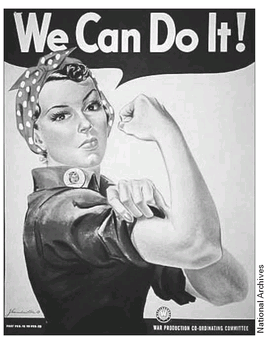
In May 1940âas Hitler invaded the Low Countries and FranceâRoosevelt issued an Executive Order, activating a National Defense Council
of business and labor leaders, headed by Frances Perkins, his Secretary of Labor. Charged with coordinating and prioritizing the massive requirements of feeding and equipping our allies and supplying the U.S. military with all that would be needed in the fight ahead, the NDC quickly realized that America's principal shortage wouldn't be raw materialsâit was labor. Though nearly ten million American men were still unemployed when the war began, Perkins and her NDC colleagues knew that almost all of them who were fit for duty would be summoned for military service, leaving gaping employment holes in agriculture and industry.
of business and labor leaders, headed by Frances Perkins, his Secretary of Labor. Charged with coordinating and prioritizing the massive requirements of feeding and equipping our allies and supplying the U.S. military with all that would be needed in the fight ahead, the NDC quickly realized that America's principal shortage wouldn't be raw materialsâit was labor. Though nearly ten million American men were still unemployed when the war began, Perkins and her NDC colleagues knew that almost all of them who were fit for duty would be summoned for military service, leaving gaping employment holes in agriculture and industry.
London had solved this problem with a universal call-up of the entire adult population of Great Britain. Men
and
women between eighteen and forty-five who were fit for military service were put in uniforms. All others were sent to work in fields and factories as directed by the British government. Those too young or old to fight or work often found themselves drafted as air raid wardens, plane spotters, teachers, child-care givers, hospital aides, drivers, message handlers, or for neighborhood civil defense.
and
women between eighteen and forty-five who were fit for military service were put in uniforms. All others were sent to work in fields and factories as directed by the British government. Those too young or old to fight or work often found themselves drafted as air raid wardens, plane spotters, teachers, child-care givers, hospital aides, drivers, message handlers, or for neighborhood civil defense.
Â
Women assembling machine parts in an airplane plant.
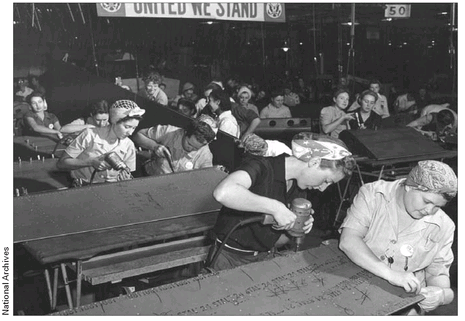
Such coercive measures were out of the question in the United States. But Perkins and the NDC also knew there was a vast, untapped workforce available: America's women. Convincing them to join the war on the home front became one of the primary goals of the Roosevelt administration in 1941â42.
Spurred by the NDC, President Roosevelt and the First Lady launched a nationwide propaganda campaign encouraging women to “Free a Man to Fight.” The theme of all the posters, billboards, newspaper, magazine, and radio ads was essentially the same: while American men served on the front lines, American women would have to serve on the assembly lines. The Office of War Information distributed posters and handbills promoting “Rosie the Riveter” and her “We can do it!” slogan. When necessary, reluctant union and industry leaders were none too gently prodded by the NDC into opening their factory floors and union halls to women by promoting women's war work as a “temporary” response to a national emergency.
The results were dramatic. Within a year of the U.S. entry into the war, more than a million American women had become hourly wage laborers in the defense industry. A year later it was 2.5 million. Many of these young women took jobs that had heretofore been male-only. In airplane plants they not only did meticulous work assembling fine machine parts and electric componentsâthey were also welders and crane operators.
By 1942, American women were assembling bombs, building tanks, welding hulls, and greasing locomotives. Phyllis McKey moved from Oregon to California and joined them.
PHYLLIS MCKEY
Kaiser Shipyards
Oakland, California
22 September 1943
Oakland, California
22 September 1943
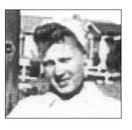
I was just twenty-one and a new mother, living in Oregon, when my husband and I and our new baby moved to California for his job. I had never
expected to work outside the home, but there was a notice in the paper that the Kaiser Shipyard had openings for women. My sister Marian came down from Oregon to help take care of the baby and I applied for a job as a welder.
expected to work outside the home, but there was a notice in the paper that the Kaiser Shipyard had openings for women. My sister Marian came down from Oregon to help take care of the baby and I applied for a job as a welder.
As an apprentice welder I made ninety cents an hourâwhich was good money. I caught on quickly and after a few weeks, I was put out in the yard where we were building Liberty ships. I think our shipyard was the first to mass-produce shipsâby pre-fabricating various pieces, then bringing the parts together from all over the yard with great big cranes and welding them together right there in the dry dock.
To build the ship's deck-houses, they laid a slab of steel down and we welded the pre-cut walls to the roof while standing on what would be the ceiling. As we finished each one, a crane would come and pick it up and carry it to the hullâwhich was also assembled in sections. There, it would be welded to the ship's deck. After we had been at it awhile we could turn out
a ship a day
âin three shifts. All it took was some spirit, energy, and a can-do attitude.
a ship a day
âin three shifts. All it took was some spirit, energy, and a can-do attitude.
While we would be welding beads in the pilot house, pipe fitters and electricians would move in and install all the water pipes and valves, electric wiring, and switchesâso that about the time we were finished with the welding, they would be done with their work. It was an amazing processâand we all took great pride in what we accomplished.
Was a woman as good a welder as a man? Better, I think. Women did embroidery work, crochet work, knitting. For those things you not only needed to know the technique, you wanted it to be beautiful. And it was the same with welding. I could run a bead weld as good or better than any man on my shiftâand that's not me talkingâthat's what my job supervisor said.
Was it hard work? Sure. It's hot and dirty, too. Those welding masks are heavyâso were the leather gloves, chaps, and gauntlets we wore to keep from getting burned. Sometimes a spark would roll down into a glove and there'd be little round BBs of hot metal burning your flesh. It was so dirty that sometimes at the end of a shift, my skin would be completely
black. But we weren't doing this to look goodâwe were doing it to help win the war and feed our families.
black. But we weren't doing this to look goodâwe were doing it to help win the war and feed our families.
After I had been there awhile, another sister came down from Oregonâshe took a job in the Kaiser drafting department. Finally, my mom came and I took a job on a graveyard shift so that we could take turns in the bed.
I was promoted to journeyman welder, making a dollar an hourâthe same pay as my husband, who was also a welder. That didn't sit well with him because he hadn't wanted me to go to work. He had expected to be the head of the householdâand that I would come and ask him for money to buy things. Well, my job at Kaiser gave me independenceâand that was something most women didn't have until the war.
Our marriage didn't surviveâbut I'm proud of what we accomplished. The women who worked in that yard built good ships that helped save a lot of lives. I never heard about any man who sailed on 'em complain about that.
Opening so many new jobs to women had not only a profound effect on the war effort, but it also had inevitable consequences on American society and culture. Before the war, less than 20 percent of women between eighteen to forty were in the salaried labor force. By 1940 it was 25 percent and by 1945 it had swelled to 35 percent. At the end of the war, with factories and shipyards running twenty-four hours a day, seven days a week, more than half of all adult American women were working outside the home. Three-quarters of the new women workers were married, most were over age thirty-five, and more than a third had children under fourteen.
The war also caused shifts in population. Americans flocked to places with military bases and defense plants; six million migrants left farms and rural areas for urban areas where defense jobs were plentiful. Often it meant taking a new job, in a new place, in a new plant, making new productsâall of which required that their new employer train these new workers. Lourelei Prior was one of those who benefited from such training when she went to work for General Electric.
Â
Free a Man to Fight.
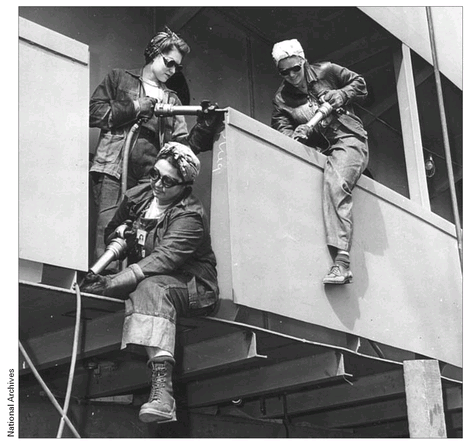
LOURELEI PRIOR
General Electric Aircraft Engine Plant
Fort Wayne, Indiana
5 November 1945
Fort Wayne, Indiana
5 November 1945
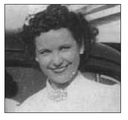
My dad died in 1936, the year I graduated from high school in the little town of Garrett, Indiana. My mother couldn't work and I had a twelve-year-old little brother so to support them, I went to work in an undergarment factory. When the war started, one of my good friends went into the Women Marines. I wanted to go with her to join up but my mom was
really upsetâthat I would be leaving her and my little brother to fend for themselves.
really upsetâthat I would be leaving her and my little brother to fend for themselves.
About that time there was a story in the newspaper about jobs in defense plants opening up for women in Fort Wayne. I applied for a job at the GE aircraft engine plant and was accepted. We all moved to Fort Wayne so that I could work at the GE plant and take care of them.
When I started at GE the first thing they did was to send me to school to teach me how to read blueprints and operate a diamond-tipped lathe and a thread-mill. After the training, I was put to work making electrical armatures for aircraft engines. At this plant they had three shifts, twenty-four hours a day, seven days a week. Those gentlemen at GE treated me like a jewel. Because I had to look after my mother and brother, they gave me a day shift.
I had several different jobs during the time that I worked at the GE plant. My first job was to cut armatures from steel stock using the lathe, then wind copper wire onto the armatures. I was responsible for the whole piece, from set-up to completion. Each armature had to be made to very exact specificationsâso it required a lot of attention to detail. And each one weighed about sixty pounds, so I had to be pretty strong. It was hard work, but satisfying to help the war effort and it paid a good wage and allowed me to support my mother and brother. It's also how I met my husband, Herbert.
The machines we used at GE had safety guards around them and Herb was responsible for maintaining the machinery and tools we used in my part of the plantâand making sure that the safety guards were in place to protect people. One of the other gals told him I was single and he started to come around a lot to check on my machines and safety guards. One day when the diamond tip broke off my lathe, the supervisor roped off the whole area and Herb and I and several others had to crawl around to find the diamond tip. Afterwards he asked me out.
We dated for a few months and decided to get married. This wasn't an easy time to be a new bride because everything was rationed. Only one person from each family was allowed to register for a “War Ration Book”
with colored stamps in it that allowed you to buy certain amounts of food, clothing, shoes, coffee, gasoline, tires, fuel oil, coalâjust about everythingâall based on the size of your family.
with colored stamps in it that allowed you to buy certain amounts of food, clothing, shoes, coffee, gasoline, tires, fuel oil, coalâjust about everythingâall based on the size of your family.
As I recall, Red Stamps were used for meat, butter, fat, cooking oil, sugar, milk, and cheese. Blue Stamps were for canned fruits and vegetables, juices, dry beans, soups, baby food and the like. But having a ration stamp didn't guarantee that something would be available. We all learned to use everything very sparingly and not waste anything. Even razor blades had to be re-sharpened. In almost every store there were posters with slogans like, “Do with less so they'll have enough,” and “Pledge to save food.”
One of the scarcest things was butterâand someone invented a vegetable-oil substituteâmargarine. It was white and came with a capsule of food coloring to mix into the margarine to make it look like butter.
We couldn't get stockings eitherâall the silk was used for parachutes and nylon hadn't been invented yet. Now, stockings didn't matter at the plant. There, all the gals wore tight clothing and pants and a hat and safety glassesâand no jewelryâbecause of the heavy machinery. But no gal or new bride wants to be seen in a skirt without stockings! So when I would go out with Herb, sometimes to make it look like I had on stockings, I would draw a black line up the back of my legs with an eyebrow liner pencil to make it look like I was wearing silk stockings.
In our house we didn't grumble about the shortages. We just thanked God for what we
did
haveâand I had four brothers-in-law who were in the service. If giving up a little bit helped the boys “over there” and would bring them back sooner, it was fine with us.
did
haveâand I had four brothers-in-law who were in the service. If giving up a little bit helped the boys “over there” and would bring them back sooner, it was fine with us.
Some people got scarce things on the black market and there were men who could have served but didn't. Men with children who worked in a defense plant and those who were sole providers didn't have to go. But Herb wanted to serve and we talked a lot about that and so just a few months after we were married, he joined the Merchant Marines.
While he was gone, my mother, brother, and I made do and helped the war effort as best we could. We had a “victory garden” for fresh vegetables and we canned the extras in Mason jars for winter. We saved anything
we didn't need for the “scrap drives” and recycled everything: tin cans, newspapers, magazines, cardboard, clothing, tin foil, bits of rubber, broken glass, paper sacks. The Boy Scouts would come to the door once a week or so to collect it or we would turn it in at our church.
we didn't need for the “scrap drives” and recycled everything: tin cans, newspapers, magazines, cardboard, clothing, tin foil, bits of rubber, broken glass, paper sacks. The Boy Scouts would come to the door once a week or so to collect it or we would turn it in at our church.
At the GE plant we were all encouraged to buy War Bonds. We could either get stamps for a “War Bond Book” at the post office, or have the money for the bond deducted from our pay. That's how I did itâand every three months I got a new bond.
Very few people in those days had carsâand during the war, there were no new cars made because all the carmakers were building jeeps, trucks, tanks, and planes. Those people who did have a car had a hard time getting gasoline and tires. Nobody had a spare tire so everyone with a car had a tire patch kit, rubber cement, and a hand-operated air pump.
These shortages and rationing and all really didn't bother us much. I got up every morning before sixâand walked to the plant to be there before seven. We got a half hour for lunch. I would usually work until fiveâsometimes later. There was a timeâit went on for about two monthsâwhen we worked seven days a week without any days off. During the war I never took any vacation. It just wouldn't have felt right to meâtaking a vacation with my husband and all those boys off at the war. They didn't get any vacation.
Before Herb left we would occasionally go out to a movie or dancing. We also went to a few of the Fort Wayne Daisies baseball games together. But while he was gone, it just didn't seem right. I figured we would celebrate when he got home. And we did!
When the war ended, there was a big parade in Fort Wayne. Herb and all the other boys came home and he went into the heating, roofing, and sheet metal business. That's when we started our family.
The war was a hard time for a lot of peopleâbut I look back on those days and can say that we did our part. I felt like I had done something for my country and was blessed that my husband made it home. Nobody came up and said “thank you,” for being a “Rosie the Riveter.” They didn't have to. Herb was grateful. That's all that mattered.
Other books
Summer of Pearls by Mike Blakely
skeletons by swarthout, glendon
A New Day (Knights Disciple Motorcycle Club Book 1) by Sophia Hampton
There's Something About Lady Mary by Sophie Barnes
One Tiny Lie: A Novel by K. A. Tucker
Billionaire Undaunted: The Billionaire's Obsession ~ Zane by J. S. Scott
nancy werlocks diary s02e11 by dawson, julie ann
Outlaw's Wrath - An MC Brotherhood Romance Boxed Set by Glass, Evelyn, Faye, Carmen, Thomas, Kathryn
Hot Little Hands by Abigail Ulman
Julie of the Wolves by Jean Craighead George
